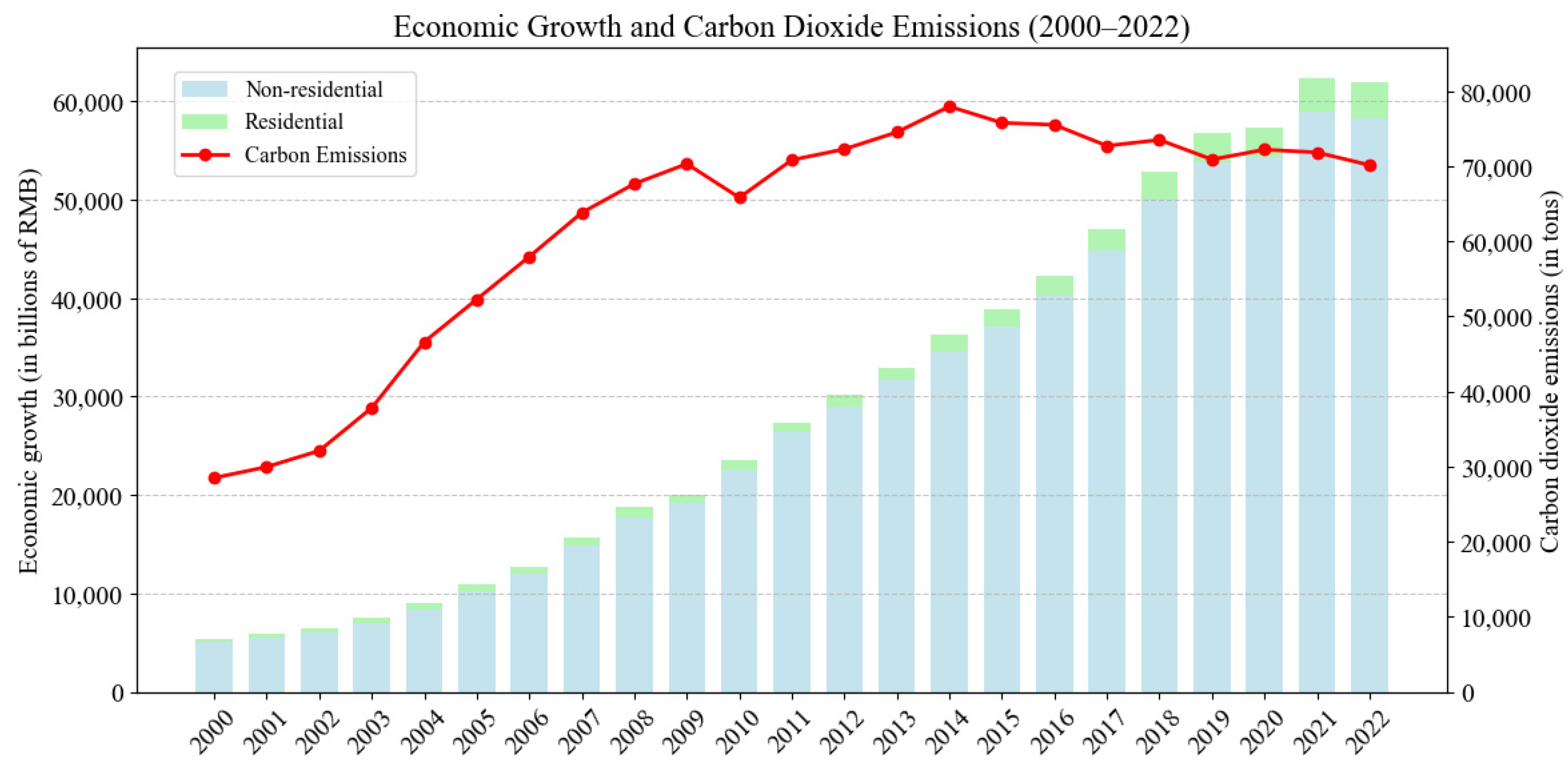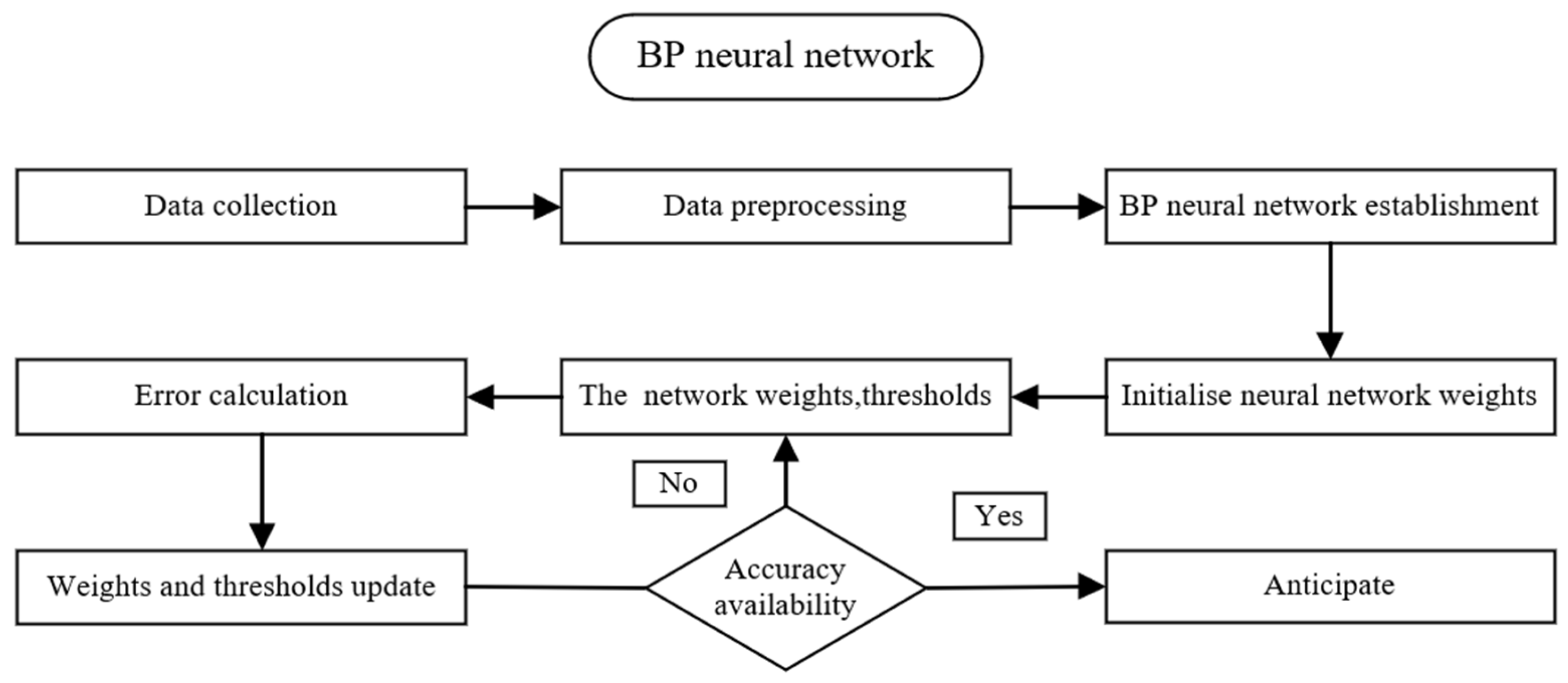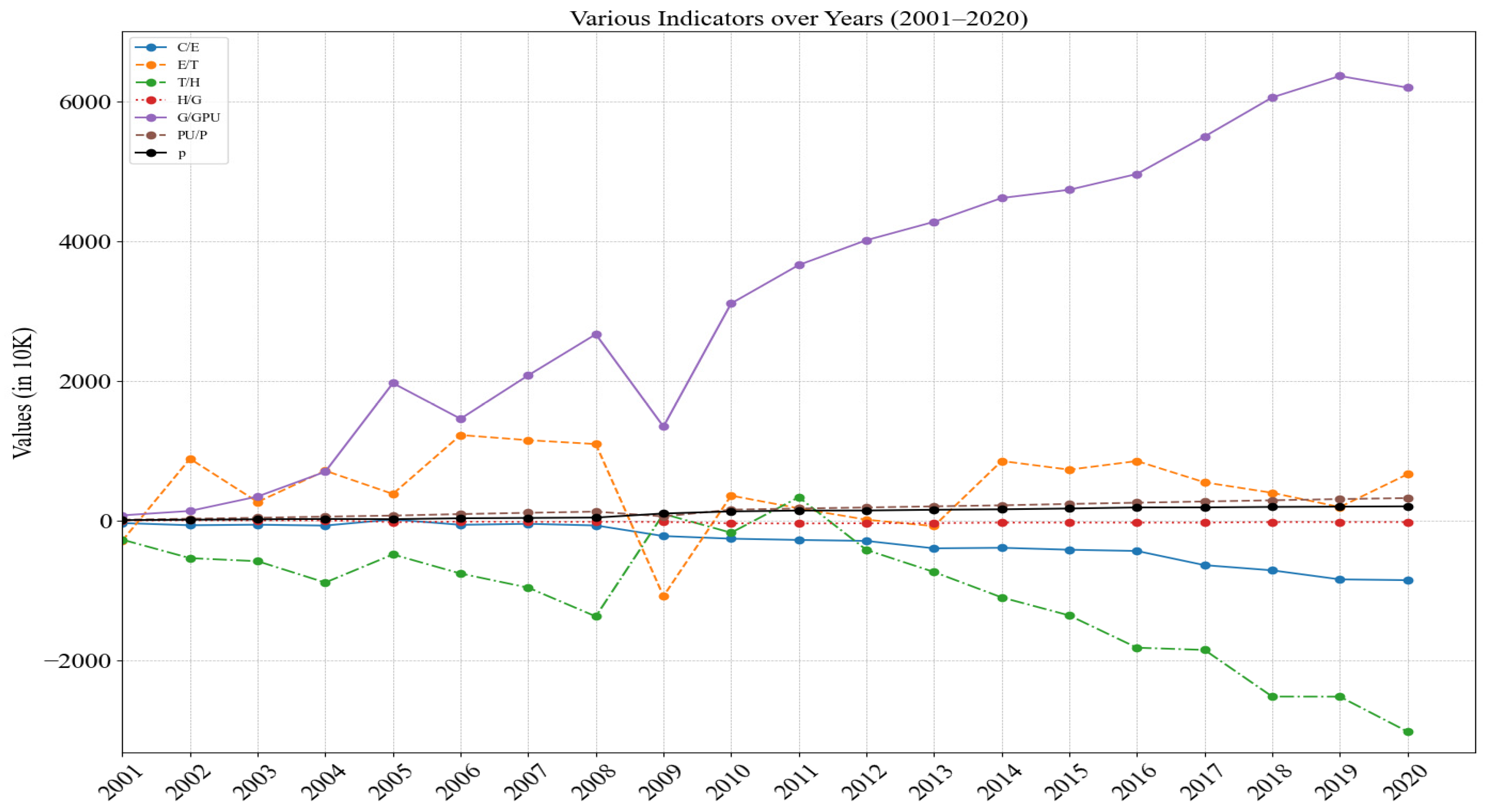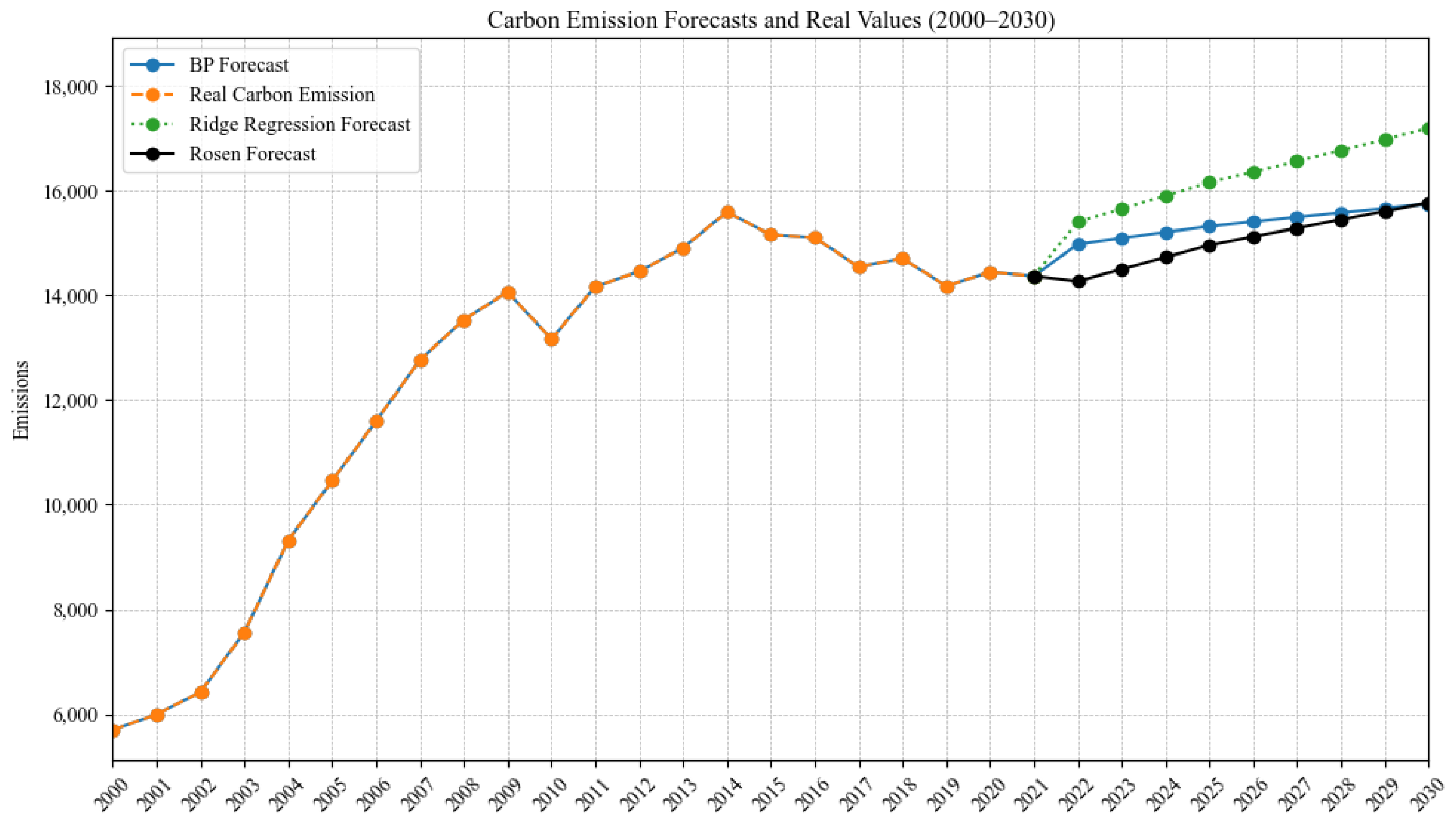Logarithmic Mean Divisia Index Analysis and Dynamic Back Propagation Neural Network Prediction of Transport Carbon Emissions in Henan Province
Abstract
1. Introduction
2. Economic Growth and Carbon Dioxide Emissions
3. Methods and Data
3.1. Date
3.2. Methodologies
3.2.1. Kaya’s Constant Equation
3.2.2. LMDI Model
3.2.3. BP Neural Network
3.2.4. Flowchart of the Methodology
4. Results
4.1. Carbon Emission
4.2. LMDI Decomposition Results
5. Transportation Carbon Emission Projections and Policy Suggestions
5.1. Model Establishment
5.2. Model Parameters and Predictive Analysis
5.3. Comparative Analysis of Forecasts
5.4. Policy Recommendations
6. Conclusions
- (1)
- This study used the LMDI decomposition method to analyse transportation-related carbon emissions in Henan Province. The results showed that transport structure, urban per capita GDP, urban–rural population ratio, and total population are key factors driving carbon emission growth, with urban per capita GDP having the largest impact, highlighting the close link between economic growth and carbon emissions. Conversely, transport energy intensity, transport turnover per unit of transport industry output, and transport industry output per unit of GDP restrain carbon emission growth, with the reduction in transport energy intensity being the most decisive. The impact of transport turnover per unit of transport industry output on carbon emissions changes in phases over time, promoting carbon emissions from 2005 to 2009 but inhibiting them from 2015 to 2019, likely due to adjustments in Henan’s transport structure and green–low-carbon development strategies.
- (2)
- This study pinpoints key factors influencing transportation-related carbon emissions in Henan and underscores the significance of policy intervention in carbon emission control. The findings offer a scientific basis for formulating and improving carbon-reduction policies in Henan’s transportation sector, hold reference value for other regions, and are crucial for achieving regional carbon emission control goals.
- (3)
- When devising future development strategies for the transportation sector, relevant departments should consider the BP neural network model’s predictive results, strengthen carbon emission control policies, and focus on two main aspects: optimizing the transport structure and boosting energy consumption efficiency. These measures can cut transport energy intensity and aid in achieving the “dual-carbon” goals.
- (4)
- Although this study constructed a comprehensive model to predict regional carbon emission trends and analyse reduction paths, there is room for expansion. Future research can improve its prediction accuracy by incorporating more machine learning models (e.g., LSTM) for comparison with or integration into the BP neural network. It can also enhance model explanatory power by refining input variables (e.g., subdividing the energy structure into different energy types and technology efficiency). Additionally, based on existing research, policy potential can be further explored. This includes analysing long-term policy-combination impacts on carbon emissions, evaluating the reduction benefits of multimodal transport and new-energy-vehicle promotion policies, and conducting cost—benefit analyses to offer policymakers more practical suggestions.
Author Contributions
Funding
Data Availability Statement
Conflicts of Interest
References
- Tutmez, B. Trend analysis for the projection of energy-related carbon dioxide emissions. Energy Explor. Exploit. 2006, 24, 139–149. [Google Scholar] [CrossRef]
- McKibbin, W.J.; Pearce, D.; Stegman, A. Long term projections of carbon emissions. Int. J. Forecast. 2007, 23, 637–653. [Google Scholar] [CrossRef]
- Wen, L.; Huang, L.L. Analysis of influencing factors of Chinese provincial carbon emissions based on projection pursuit model and Markov transfer matrix. Int. J. Clim. Change Strateg. Manag. 2019, 11, 406–423. [Google Scholar] [CrossRef]
- Wang, S.; Wang, Y.X.; Zhou, C.X.; Wang, X.L. Projections in Various Scenarios and the Impact of Economy, Population, and Technology for Regional Emission Peak and Carbon Neutrality in China. Int. J. Environ. Res. Public Health 2022, 19, 12126. [Google Scholar] [CrossRef]
- Abbas, S.; Yousaf, H.; Khan, S.; Rehman, M.Z.; Blueschke, D. Analysis and Projection of Transport Sector Demand for Energy and Carbon Emission: An Application of the Grey Model in Pakistan. Mathematics 2023, 11, 1443. [Google Scholar] [CrossRef]
- Chang, L.; Mohsin, M.; Hasnaoui, A.; Taghizadeh-Hesary, F. Exploring carbon dioxide emissions forecasting in China: A policy-oriented perspective using projection pursuit regression and machine learning models. Technol. Forecast. Soc. Change 2023, 197, 122872. [Google Scholar] [CrossRef]
- Lyu, Y.; Zhang, L.F.; Wang, D. Does digital economy development reduce carbon emission intensity? Front. Ecol. Evol. 2023, 11, 1176388. [Google Scholar] [CrossRef]
- Zhai, J.J.; She, L.H.; Hao, S.P.; Liu, H.M. Projection of regional carbon emissions and analysis of emission reduction potential under multiple scenarios. Energy Rep. 2023, 9, 753–761. [Google Scholar] [CrossRef]
- Zhang, S.H.; Dong, H.N.; Lu, C.; Li, W. Carbon Emission Projection and Carbon Quota Allocation in the Beijing-Tianjin-Hebei Region of China under Carbon Neutrality Vision. Sustainability 2023, 15, 15306. [Google Scholar] [CrossRef]
- Wu, H.; Yue, Y.; Shen, Y. Agricultural Carbon Emissions in China: Estimation, Influencing Factors, and Projection of Peak Emissions. Pol. J. Environ. Stud. 2024, 33, 4791–4806. [Google Scholar] [CrossRef]
- Wang, W.W.; Liu, X.; Zhang, M.; Song, X.F. Using a new generalized LMDI (logarithmic mean Divisia index) method to analyze China’s energy consumption. Energy 2014, 67, 617–622. [Google Scholar] [CrossRef]
- Ang, B.W. LMDI decomposition approach: A guide for implementation. Energy Policy 2015, 86, 233–238. [Google Scholar] [CrossRef]
- Lin, B.Q.; Long, H.Y. Emissions reduction in China’s chemical industry—Based on LMDI. Renew. Sustain. Energy Rev. 2016, 53, 1348–1355. [Google Scholar] [CrossRef]
- Goh, T.; Ang, B.W. Tracking economy-wide energy efficiency using LMDI: Approach and practices. Energy Effic. 2018, 12, 829–847. [Google Scholar] [CrossRef]
- Ma, L.W.; Chong, C.H.; Zhang, X.; Liu, P.; Li, W.Q.; Li, Z.; Ni, W.D. LMDI Decomposition of Energy-Related CO2 Emissions Based on Energy and CO2 Allocation Sankey Diagrams: The Method and an Application to China. Sustainability 2018, 10, 344. [Google Scholar] [CrossRef]
- Zhou, J.G.; Yu, X.C.; Guang, F.T.; Li, W. Analyzing and Predicting CO2 Emissions in China Based on the LMDI and GA-SVM Model. Pol. J. Environ. Stud. 2018, 27, 927–938. [Google Scholar] [CrossRef]
- Li, J.X.; Chen, Y.N.; Li, Z.; Huang, X.T. Low-carbon economic development in Central Asia based on LMDI decomposition and comparative decoupling analyses. J. Arid. Land 2019, 11, 513–524. [Google Scholar] [CrossRef]
- Chontanawat, J.; Wiboonchutikula, P.; Buddhivanich, A. An LMDI decomposition analysis of carbon emissions in the Thai manufacturing sector. Energy Rep. 2020, 6, 705–710. [Google Scholar] [CrossRef]
- Isik, M.; Sarica, K.; Ari, I. Driving forces of Turkey’s transportation sector CO2 emissions: An LMDI approach. Transp. Policy 2020, 97, 210–219. [Google Scholar] [CrossRef]
- Jiang, S.; Zhu, Y.N.; He, G.H.; Wang, Q.M.; Lu, Y.J. Factors influencing China’s non-residential power consumption: Estimation using the Kaya-LMDI methods. Energy 2020, 201, 117719. [Google Scholar] [CrossRef]
- Yasmeen, H.; Wang, Y.; Zameer, H.; Solangi, Y.A. Decomposing factors affecting CO2 emissions in Pakistan: Insights from LMDI decomposition approach. Environ. Sci. Pollut. Res. 2020, 27, 3113–3123. [Google Scholar] [CrossRef] [PubMed]
- Zhang, W.; Tang, X.; Yang, G.L.; Zha, D.L. Decomposition of CO2 emission intensity in Chinese MIs through a development mode extended LMDI method combined with a production-theoretical approach. Sci. Total Environ. 2020, 702, 134787. [Google Scholar] [CrossRef] [PubMed]
- Dolge, K.; Blumberga, D. Key Factors Influencing the Achievement of Climate Neutrality Targets in the Manufacturing Industry: LMDI Decomposition Analysis. Energies 2021, 14, 8006. [Google Scholar] [CrossRef]
- He, Y.; Xing, Y.T.; Zeng, X.C.; Ji, Y.J.; Hou, H.M.; Zhang, Y.; Zhu, Z. Factors influencing carbon emissions from China’s electricity industry: Analysis using the combination of LMDI and K-means clustering. Environ. Impact Assess. Rev. 2022, 93, 106724. [Google Scholar] [CrossRef]
- Korica, P.; Cirman, A.; Gotvajn, A.Z. Comparison of end-of-life vehicles management in 31 European countries: A LMDI analysis. Waste Manag. Res. 2022, 40, 1156–1166. [Google Scholar] [CrossRef]
- Ye, L.; Du, P.; Wang, S. Industrial carbon emission forecasting considering external factors based on linear and machine learning models. J. Clean. Prod. 2024, 434, 140010. [Google Scholar] [CrossRef]
- Li, Y.; Wang, Z.; Liu, S. Enhance carbon emission prediction using bidirectional long short-term memory model based on text-based and data-driven multimodal information fusion. J. Clean. Prod. 2024, 471, 143301. [Google Scholar] [CrossRef]
- Ding, Q.; Xiao, X.; Kong, D. Estimating energy-related CO2 emissions using a novel multivariable fuzzy grey model with time-delay and interaction effect characteristics. Energy 2023, 263, 126005. [Google Scholar] [CrossRef]
- Zhang, L.; Wang, F.L.; Sun, T.; Xu, B. A constrained optimization method based on BP neural network. Neural Comput. Appl. 2018, 29, 413–421. [Google Scholar] [CrossRef]
- Pan, X.Q.; Zhou, W.S.; Lu, Y.; Sun, N. Prediction of Network Traffic of Smart Cities Based on DE-BP Neural Network. IEEE Access 2019, 7, 55807–55816. [Google Scholar] [CrossRef]
- Gao, C.X.; Hu, Q.P.; Bao, L.X. Inventory, Dynamic Evolution, and Scenario Projections of Agricultural Carbon Emissions in Shandong Province, China. Sustainability 2024, 16, 3196. [Google Scholar] [CrossRef]









| Agencies | Coals | Petrochemical | Petroleum | Electrical Power |
|---|---|---|---|---|
| Climate Change Programme of the National Science and Technology Commission of China | 0.726 | 0.583 | 0.409 | 0.1229 |
| Carbon emissions from energy type | Consumption of energy type | ||
| Converted turnover of category transport | Value of transport output | ||
| Urban population | Energy carbon emission factor | ||
| Level of energy consumption per unit of transport | Transport turnover per unit of output | ||
| Value of transport output per unit of | Per capita GDP of urban residents | ||
| Urbanisation rate |
| C/E | E/T | T/H | H/G | G/PU | PU/P | P | |
|---|---|---|---|---|---|---|---|
| 2001 | −0.0036 | −0.0287 | −0.2732 | 0.0023 | 0.0748 | 0.0123 | 0.0067 |
| 2002 | −0.0031 | 0.1173 | −0.2647 | 0.0015 | 0.0632 | 0.0137 | 0.0058 |
| 2003 | 0.0008 | 0.1778 | −0.0438 | −0.0006 | 0.2068 | 0.014 | 0.0054 |
| 2004 | −0.0012 | 0.4480 | −0.3057 | −0.0001 | 0.3549 | 0.017 | 0.005 |
| 2005 | 0.0021 | 0.1834 | 0.6629 | −0.0196 | 0.4262 | 0.0175 | 0.0051 |
| 2006 | −0.0010 | 0.3268 | −0.5339 | 0.0006 | 0.3316 | 0.0185 | 0.0052 |
| 2007 | 0.0014 | −0.0735 | −0.2016 | −0.0033 | 0.6212 | 0.0184 | 0.0049 |
| 2008 | −0.0023 | −0.0556 | −0.4124 | 0.0004 | 0.5890 | 0.0169 | 0.0049 |
| 2009 | −0.0011 | −2.3378 | 4.6492 | −0.0159 | 0.1414 | 0.0167 | 0.0049 |
| 2010 | −0.0179 | −0.5047 | 0.7332 | −0.0044 | 0.2990 | 0.0112 | 0.0833 |
| 2011 | −0.0018 | −0.1811 | 0.5083 | −0.0020 | 0.5506 | 0.0165 | 0.0122 |
| 2012 | −0.0014 | −0.1634 | −0.7535 | 0.0032 | 0.3550 | 0.0152 | 0.001 |
| 2013 | −0.0106 | −0.0916 | −0.3171 | 0.0016 | 0.2630 | 0.0161 | 0.0107 |
| 2014 | 0.0008 | 0.9320 | −3.6345 | 0.0071 | 0.3406 | 0.0145 | 0.0063 |
| 2015 | −0.0028 | −0.1241 | −0.2584 | 0.0003 | 0.1182 | 0.0197 | 0.0115 |
| 2016 | −0.0018 | 0.1236 | −0.4620 | −0.0006 | 0.2258 | 0.0176 | 0.0153 |
| 2017 | −0.0203 | −0.3051 | −0.0319 | 0.0001 | 0.5357 | 0.0178 | 0.0007 |
| 2018 | −0.0074 | −0.1497 | −0.6678 | 0.0085 | 0.5602 | 0.0168 | 0.0067 |
| 2019 | −0.0129 | −0.2043 | −0.0013 | −0.0002 | 0.3063 | 0.0177 | 0.0042 |
| 2020 | −0.0011 | 0.4702 | −0.5002 | −0.0003 | −0.1663 | 0.0142 | 0.004 |
| aggregate | −0.0853 | −1.4404 | −2.1084 | −0.0213 | 6.1973 | 0.3223 | 0.2038 |
| Energy Consumption | Gross Domestic Production | Total Population | Value Added of Transport | Conversion Turnover | Urban Population | |
|---|---|---|---|---|---|---|
| 2025 | 1.02 | 1.06 | 1.005 | 1.06 | 1.07 | 1.015 |
| 2030 | 1.015 | 1.05 | 1.0048 | 1.05 | 1.06 | 1.012 |
Disclaimer/Publisher’s Note: The statements, opinions and data contained in all publications are solely those of the individual author(s) and contributor(s) and not of MDPI and/or the editor(s). MDPI and/or the editor(s) disclaim responsibility for any injury to people or property resulting from any ideas, methods, instructions or products referred to in the content. |
© 2025 by the authors. Licensee MDPI, Basel, Switzerland. This article is an open access article distributed under the terms and conditions of the Creative Commons Attribution (CC BY) license (https://creativecommons.org/licenses/by/4.0/).
Share and Cite
Mao, C.; Luo, J.; Jiao, S.; Zhao, B. Logarithmic Mean Divisia Index Analysis and Dynamic Back Propagation Neural Network Prediction of Transport Carbon Emissions in Henan Province. Energies 2025, 18, 1630. https://doi.org/10.3390/en18071630
Mao C, Luo J, Jiao S, Zhao B. Logarithmic Mean Divisia Index Analysis and Dynamic Back Propagation Neural Network Prediction of Transport Carbon Emissions in Henan Province. Energies. 2025; 18(7):1630. https://doi.org/10.3390/en18071630
Chicago/Turabian StyleMao, Changjiang, Jian Luo, Shengyang Jiao, and Bin Zhao. 2025. "Logarithmic Mean Divisia Index Analysis and Dynamic Back Propagation Neural Network Prediction of Transport Carbon Emissions in Henan Province" Energies 18, no. 7: 1630. https://doi.org/10.3390/en18071630
APA StyleMao, C., Luo, J., Jiao, S., & Zhao, B. (2025). Logarithmic Mean Divisia Index Analysis and Dynamic Back Propagation Neural Network Prediction of Transport Carbon Emissions in Henan Province. Energies, 18(7), 1630. https://doi.org/10.3390/en18071630





